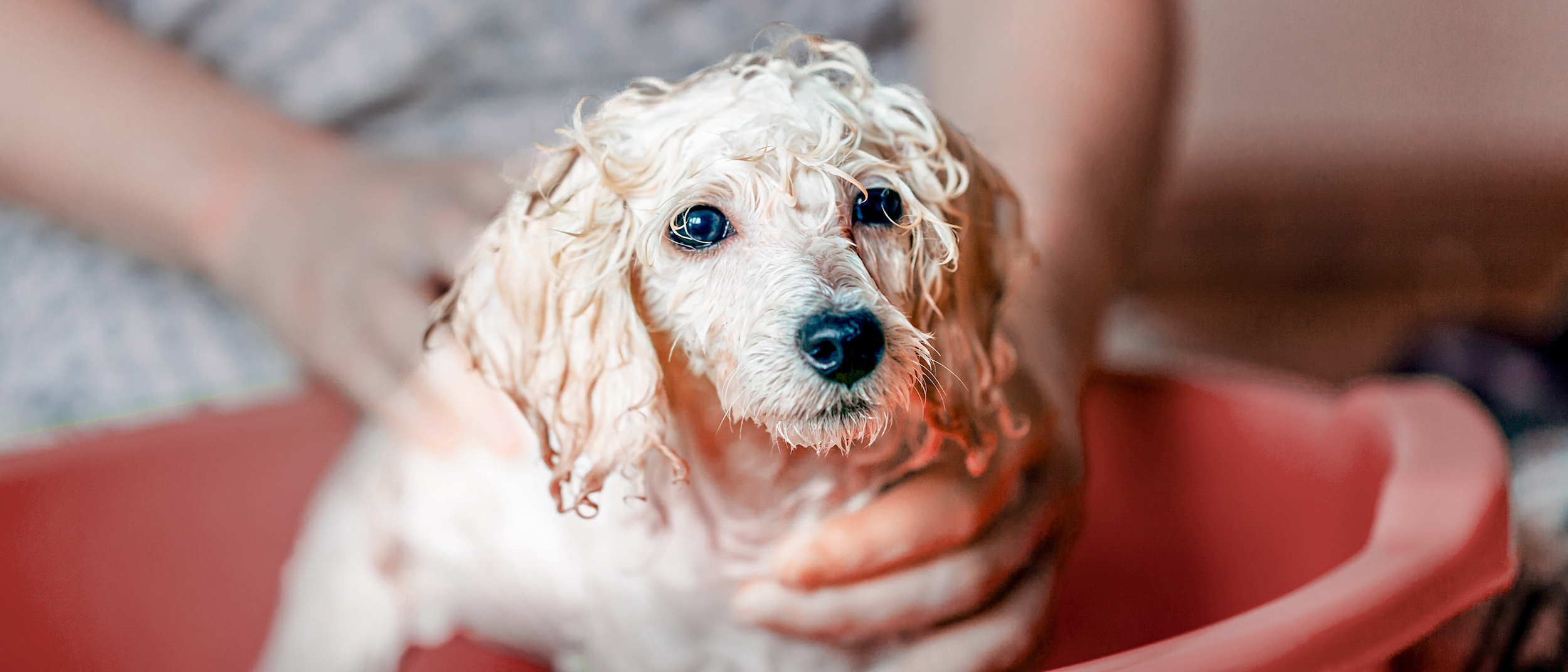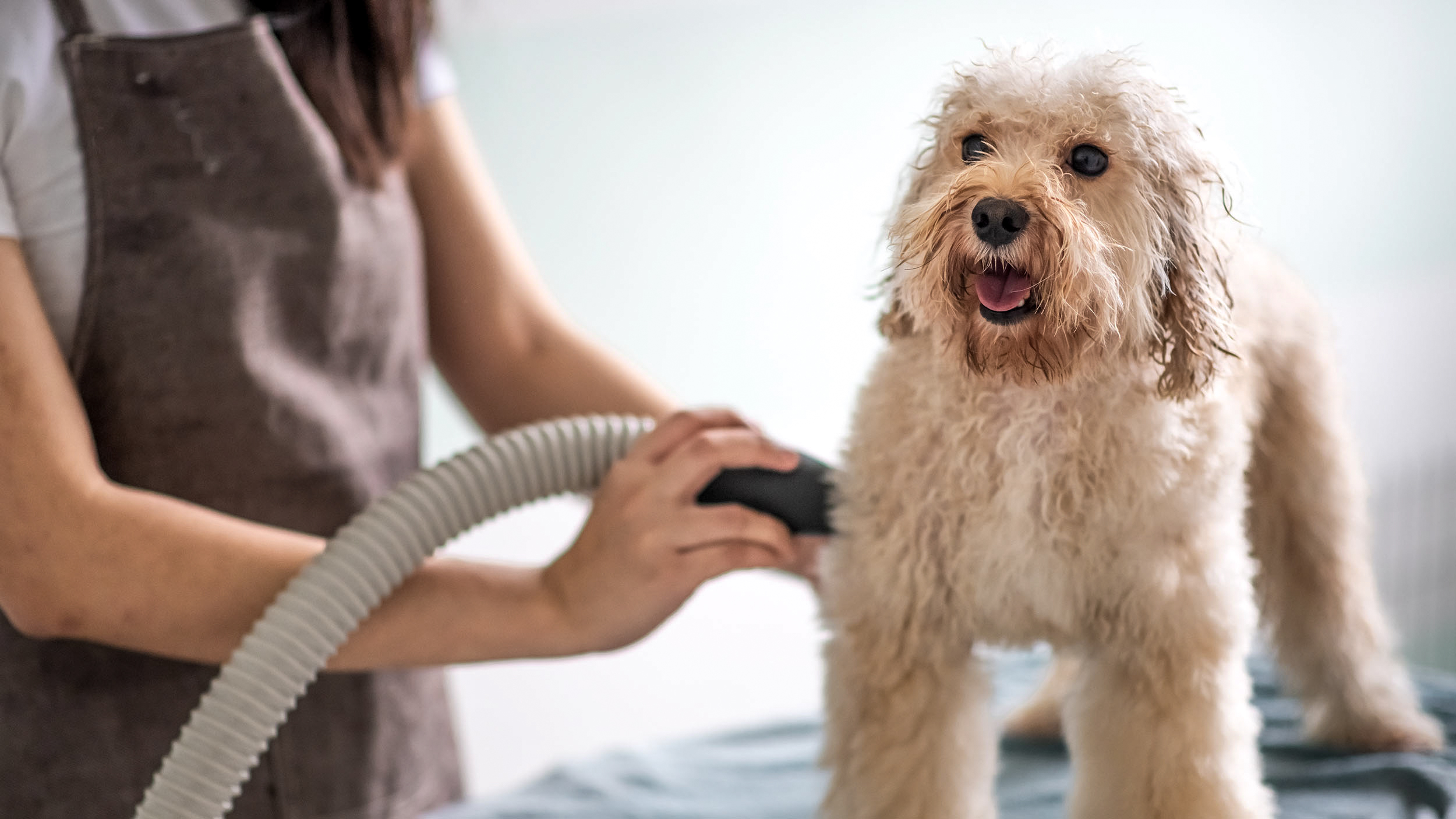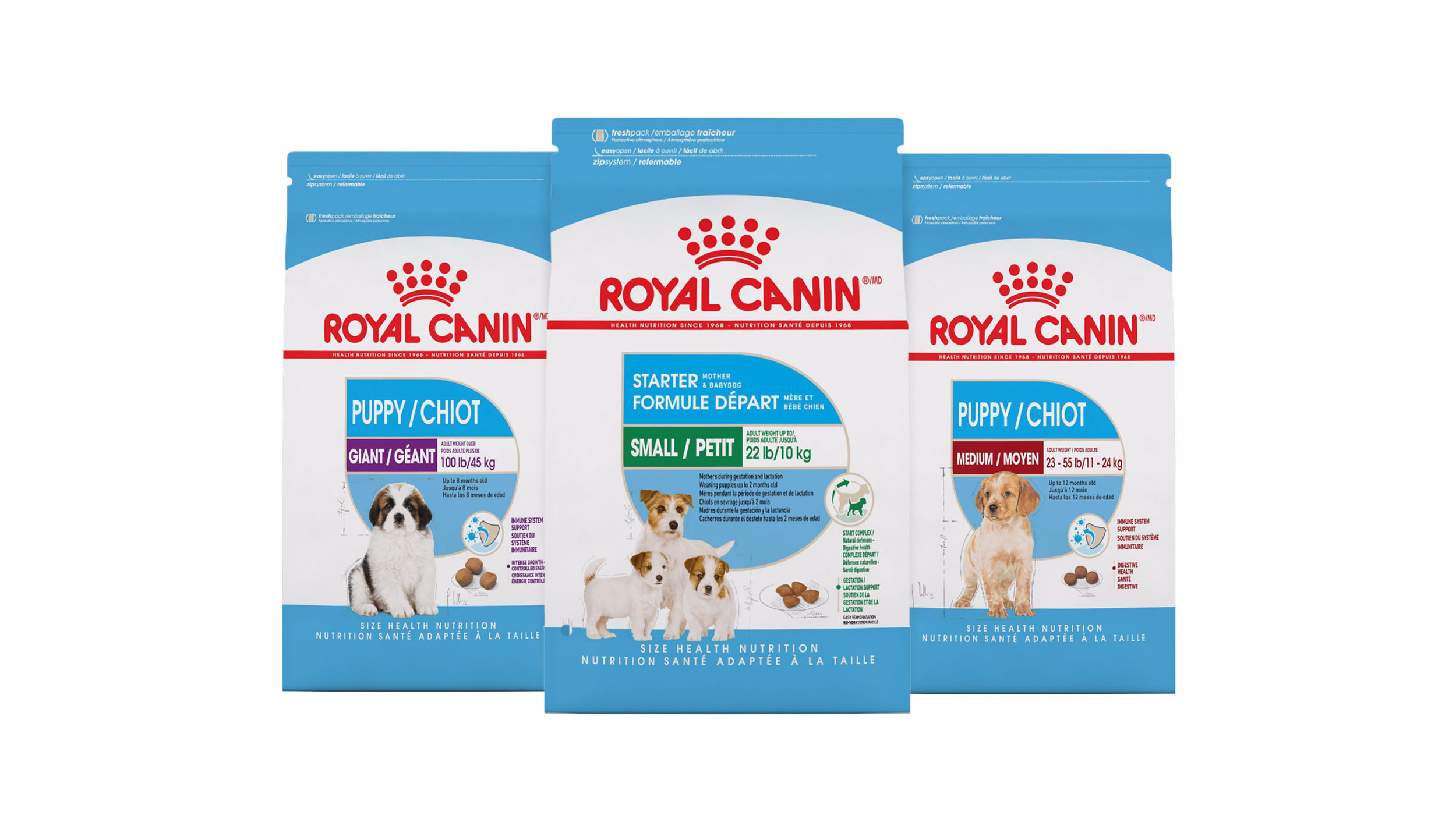Ráðleggingar um snyrtingu og hreinlæti hvolpsins

Að baða hvolp
Tíðni baða fer eftir feldgerðinni. Snögghærða hunda á aðeins að baða ef þeir eru óhreinir. Það nægir að baða snögghærða hvolpa að meðaltali tvisvar á ári og síðhærða hvolpa á þriggja mánaða fresti eða svo.
Ef hundurinn þinn hefur gaman af því að synda, ættir þú að skola feldinn eftir sundferðina. Alls kyns örður úr ám og sjó sem sitja eftir í feldinum geta valdið óþægindum í húðinni en hægt er að koma í veg fyrir það með því að skola feldinn vel.
Áður en þú baðar, skaltu bursta vandlega í gegnum feldinn til að losa allar flækjur og hnúta. Að svo búnu skaltu bleyta allan feldinn, bera svo sjampó í hann og nudda þar til það freyðir. Gættu þess að sjampó berist hvorki í augu né eyru. Baðvatnið á að vera ylvolgt og sjampóið á að vera sérstaklega ætlað hvolpum því annars er hætta á að það valdi óþægindum og raski náttúrulegu sýrustigi húðarinnar.
Láttu sjampóið liggja í feldinum í nokkrar mínútur og skolaðu það síðan vandlega úr með vatni. Best er að enda á því að skola höfuðið því hvolpurinn vill að öllum líkindum hrista höfuðið.
Að þurrka hvolpinn eftir bað
Þurrkaðu hvolpinn vandlega eftir baðið og hafðu hann í hlýju herbergi þar til feldurinn er orðinn þurr. Ef hlýtt er í veðri má þurrka hann úti í garði eða fara í gönguferð svo framarlega sem hann sækist ekki í að velta sér upp úr for. Hægt er að þurrka feldinn með hárblásara ef hvolpurinn er sáttur við það en þá þarf að gæta þess að brenna ekki feldhárin með of heitum blæstri og sömuleiðis er mikilvægt að bursta feldinn um leið og hann er blásinn.
Að hreinsa tjöru úr hvolpafeldi
Hreinsiefni með olíu geta verið mjög eitruð og því á alls ekki að nota þau ef tjara kemst í feld hvolpsins. Berðu jurtaolíu á blettina, bíddu í nokkrar mínútur meðan tjaran leysist upp og baðaðu síðan hundinn.
Að klippa klær á hvolpinum
Hundar hafa tvær gerðir af klóm, svokallaðar smalaklær og táklær. Báðar gerðirnar vaxa stöðugt. Klær á tánum eyðast venjulega þegar hundurinn gengur á hörðu undirlagi en ef þær vaxa fram, þarf að klippa þær.
Hirða þarf um klær á öllum hvolpum. Vanalega þarf ekki að klippa klær á hvolpum en ef þú heyrir í klónum þegar hundurinn gengur á gólfinu, má klippa þær. Biddu dýralækninn að sýna þér bestu aðferðina við að klippa klærnar.
Að bursta hvolpinn og greiða honum
Rétt eins og hjá mannfólkinu, vex hár á hundum og deyr síðan. Útihundar fara úr hárum tvisvar á ári (á vorin og haustin) í samræmi við breytingar á dagsbirtu. Breytingar á dagsbirtu hafa ekki jafn mikil áhrif á innihunda svo þeir fara úr hárum allan ársins hring en þó meira á vorin og haustin. Hægt er að ná lausum feldhárum með því að bursta feldinn reglulega og baða hundinn. Tíðni snyrtinga og áhöld fara eftir því hvers eðlis feldurinn er.
Að bursta snögghærða hvolpa
Þótt snögghærðir hundar þurfi ekki eiginlega snyrtingu, þarf að bursta feldinn af og til. Ef feldurinn er burstaður upp á við, með gúmmíbursta, losnar um dauða húð og dauð hár. Best er að bursta kusk úr feldinum mjúkum bursta og bursta í sömu átt og hárin liggja. Ljúktu snyrtingunni með því að strjúka yfir feldinn með rökum klút úr vaskaskinni.
Að snyrta hvolpa, snögghærða eða með miðlungs síðan feld
Það þarf að bursta feldinn að minnsta kosti einu sinni í viku, eftir því hve þykkur hann er og skal þá bæði tekið mið af undirfeldi og yfirfeldi. Notaðu slikkerbursta og greiddu hárin í gagnstæða átt (upp á við). Með því móti losar þú dauð feldhár og hreinsar úr undirfeldinum. Þú getur síðan burstað gegnum feldinn með mjúkum bursta og losnað þannig við dauðu feldhárin.
Gott er að nota grófa greiðu til að greiða í gegnum skottið og hár á þófum. Feldinn á strýhærðum hundum þarf að reyta fjórum til fimm sinnum á ári með reytingarhníf og þumalfingri. Þetta veldur hundinum engum sársauka ef rétt er farið af og hárin reytt í sömu átt og hárin vaxa.
Að bursta síðhærða hvolpa
Síður feldur er vissulega fallegur en hann þarf líka að bursta daglega. Það getur tekið allt að klukkutíma, til dæmis ef um Afghan-hund er að ræða. Notaðu slikkerbursta og burstaðu í sömu átt og hárin liggja til að losa hnúta og flækjur. Hætt er við að það strekkist á húðinni af því feldhárin eru löng, svo nauðsynlegt er að fara varlega til að meiða ekki hvolpinn.
Ef mjúkur bursti er notaður til að bursta hunda með silkikenndan feld eins og Yorkshire Terrier eða Afghan Hound, fær feldurinn meiri gljáa.
Hægt er að nota bursta með teinum til að losa burt óhreinindi úr feldi hunda með mikinn undirfeld eins og Rough Collie.
Gott er að nota grófa greiðu til að losa flækjur aftan á hækilbeini.
Eftir notkun þarf að þrífa öll snyrtiáhöld og geyma síðan á þurrum stað. Til að komast hjá því að járnteinar í burstunum ryðgi, er gott að þurrka þá vel og bera á þá olíu með klút.

Munnhirða hvolpsins þíns
Hundum er lítið um það gefið að fólk sé með hendurnar í munninum á þeim svo það er skynsamlegt að venja hvolpinn á það frá upphafi.
Gómurinn á að vera bleikur á litinn. Roði í kringum tennurnar er merki um bólgu og sjúkdóm sem getur valdið því að hundurinn borði minna, ekki síst ef hann finnur til eða ef hann getur ekki tuggið fóðrið sitt. Undir slíkum kringumstæðum þarf dýralæknir að skoða hundinn.
Hvernig á að bursta tennurnar í hundi?
Best er að bursta tennurnar nokkrum sinnum í viku með tannbursta og tannkremi sem er sérstaklega ætlað hundum.
Önnur leið er sú að gefa honum nagbein sem dregur úr myndun tannsteins og fjölgun tannsýkla. Æskilegt er að gefa hundinum nagbein tvisvar til þrisvar sinnum í viku til að varna því að tannsteinn og tannsýkla myndist. Spurðu dýralækninn hvaða gerð henti hundinum best.
Eyru hvolpsins hreinsuð
Eyru hunda eru ýmist upprétt eða lafandi. Lafandi eyru ætti að skoða oftar þar sem ekki loftar eins vel um eyrnagöngin og á uppréttum eyrum.
Hægt er að hreinsa eyrun samkvæmt ráðleggingum dýralæknis og með sérstökum hreinsivökva. Láttu fremsta hluta stútsins í eyrnagöngin og kreistu varlega einn til tvo dropa. Nuddaðu neðanvert eyrað mjög varlega í 30 sekúndur og gættu þess að hundurinn hristi ekki höfuðið. Þurrkaðu svo eyrað með bómullarhnoðra.
Augu hvolpsins hreinsuð
Augun eiga að vera lífleg og rök. Slímhúðin á að vera ljósbleik. Það er mikilvægt að þrífa alla útferð frá augunum en það myndast alltaf tárataumar þegar hár liggja nálægt augunum. Tárataumar myndast af því hárin sjúga í sig rakann sem augun framleiða.
Hægt er að þrífa óhreinindi kringum augun og einnig tárataumana með bómullarhnoðra sem vættur hefur verið í hreinu volgu vatni. Gættu þess að nudda mjög varlega kringum augun.
Hvort sem ætlunin er að fara með hundinn til hundasnyrtis þegar hann verður fullorðinn eða ekki, er skynsamlegt að venja hann við almenna umhirðu og snyrtingu frá unga aldri. Það kemur í veg fyrir að hann verði ósáttur eða órólegur í snyrtingu þegar hann eldist.
Related Articles

Sérsniðin næring fyrir hvolpinn þinn
Mikið úrval er til af fóðri sem styrkir varnarkerfi og heilbrigðan vöxt ásamt því að þroska meltingarkerfið.
Líkaðu við og deildu þessari síðu